This is a list of ship designs by the Emergency Fleet Corporation, since the corporation's inception in 1917.
This is a list of ship designs by the Emergency Fleet Corporation, since the corporation's inception in 1917.
Note: Some ships had turbines, other ships had triple expansion engines, not both. Some cargo ships were converted to reefers, not all ships of a cargo type design. Some ships burned coal, others oil, not both. Unless otherwise noted.
| Name | Type | dwt | length | beam | draft | engines | fuel | East | West | L/G | Built | Cancelled | additional built |
|---|---|---|---|---|---|---|---|---|---|---|---|---|---|
| 1012 | cargo | 6,000 | 333 | 46 | 25 | turbine | oil | 4 | 17 | ||||
| 1013 | 8,800 | 410.5 | 54 | 30 | turbine triple | oil coal | 5 | 106 | 5 | ||||
| 1014 | 7,500 | 380 | 53 | 27 | triple | oil | 1 or 2 | 20 | 14 | 2 | |||
| 1015 | cargo reefer | 9,400 | 402 | 53 | 32 | turbine triple | oil | 2 | 5 | 84 | |||
| 1016 | cargo | 8,800 | 410 | 54 | 27 | turbine | oil | 1 | 14 | ||||
| 1017 | 7,500 | 387 | 52 | 27 | triple | oil | 1 | 10 | 1 | ||||
| 1018 | 10,000 | 434 | 58 | 27.2 | triple | oil | 1 | 5 | 1 | ||||
| 1019 | 8,600 | 410.5 | 54 | 27 | turbine triple | oil coal | 1 | 3 | 54 | 1 | |||
| 1020 | 3,500 | 251 | 43.5 | 22.5 | triple | coal | 92 | ||||||
| 1021 | 6,000 | 340.5 | 48 | 27.2 | turbine | oil | 1 | 3 | |||||
| 1022 | 7,500 | 390 | 54 | 27.5 | turbine | oil | 1 | 110 | |||||
| 1023 | 5,075 | 324 | 46 | 25 | turbine triple | oil | 2 | 118 | 32 | 36 | |||
| 1024 | troop | 8,000 | 437 | 58 | 36 | turbine | oil | 1 | 70 | 58 | |||
| 1025 | cargo | 9,000 | 401 | 54 | 29.9 | turbine | oil | 2 | 1 | 62 | |||
| 1027 | cargo | 9,500 | 402 | 54 | 34.4 | triple | oil | 1 | 10 | ||||
| 1029 | troop | 13,000 | 517 | 72 | 28 | turbine | oil | ||||||
| 1031 | |||||||||||||
| 1032 | |||||||||||||
| 1037 | |||||||||||||
| 1038 | |||||||||||||
| 1041 | |||||||||||||
| 1042 | |||||||||||||
| 1043 | |||||||||||||
| 1044 | |||||||||||||
| 1045 | |||||||||||||
| 1046 | |||||||||||||
| 1047 | |||||||||||||
| 1049 |

A port is a maritime facility comprising one or more wharves or loading areas, where ships load and discharge cargo and passengers. Although usually situated on a sea coast or estuary, ports can also be found far inland, such as Hamburg, Manchester and Duluth; these access the sea via rivers or canals. Because of their roles as ports of entry for immigrants as well as soldiers in wartime, many port cities have experienced dramatic multi-ethnic and multicultural changes throughout their histories.

Liberty ships were a class of cargo ship built in the United States during World War II under the Emergency Shipbuilding Program. Although British in concept, the design was adopted by the United States for its simple, low-cost construction. Mass-produced on an unprecedented scale, the Liberty ship came to symbolize U.S. wartime industrial output.
Holland America Line is a US-owned cruise line, a subsidiary of Carnival Corporation & plc headquartered in Seattle, Washington, United States.

The Bogue class were a class of 45 escort carriers built in the United States for service with the US Navy and the Royal Navy, through the Lend-Lease program, during World War II. Following the war, ten Bogue-class ships were kept in service by the US Navy and were reclassified for helicopter and aircraft transport operations.

SS American Victory is a Victory ship which saw brief service in the Pacific Theater of Operations during the final months of World War II, the Korean War from 1951–1954, and the Vietnam War from 1966–1969. Built in June 1945, she carried ammunition and other cargo from Los Angeles to Southeast Asia, then ferried cargo, equipment and troops back to the U.S. after the war ended. She survived two typhoons and one hurricane.
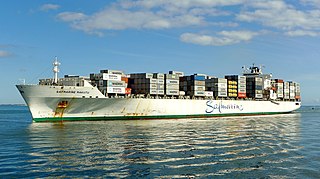
Safmarine, short for South African Marine Corporation, and latterly South African Marine Container Lines, was a South African shipping line, established in 1946, which offered freight transport services with cargo liners and container ships. It was bought by Maersk Line in 1999, and was fully integrated into that company in 2020. It also operated passenger vessels and specialised cargo ships.
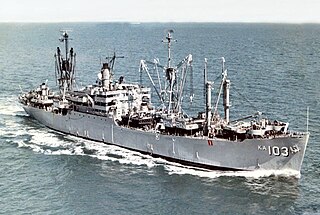
Amphibious cargo ships were U.S. Navy ships designed specifically to carry troops, heavy equipment and supplies in support of amphibious assaults, and to provide naval gunfire support during those assaults. A total of 108 of these ships were built between 1943 and 1945—which worked out to an average of one ship every eight days. Six additional AKAs, featuring new and improved designs, were built in later years. They were originally called Attack Cargo Ships and designated AKA. In 1969, they were renamed as Amphibious Cargo Ships and redesignated LKA.

Coastal trading vessels, also known as coasters or skoots, are shallow-hulled merchant ships used for transporting cargo along a coastline. Their shallow hulls mean that they can get through reefs where deeper-hulled seagoing ships usually cannot, but as a result they are not optimized for the large waves found on the open ocean. Coasters can load and unload cargo in shallow ports. For European inland waterways, they are limited to a 33,49 m beam.
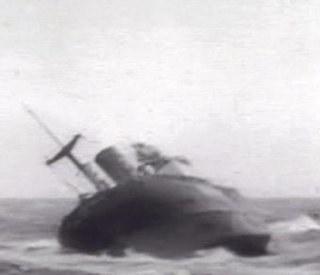
SS Flying Enterprise was a 6,711 ton Type C1-B ship which sank off Cornwall in 1952. She was built in 1944 as SS Cape Kumukaki for the United States Maritime Commission for use in World War II. The ship was sold in 1947 and operated in scheduled service under the name Flying Enterprise. On a voyage from Hamburg to the USA with mixed cargo and a few passengers, she was crippled by storm damage and shifting cargo. Passengers and crew were evacuated. Three weeks of effort to save the ship having failed, she sank and some of the cargo was later salvaged.
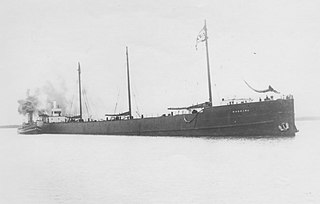
Madeira was a schooner barge that sank off the coast of Minnesota in Lake Superior on November 28, 1905. A schooner barge is a type of ship that functions like a barge, in that it is towed by a steamship, but also has sails like a schooner. This type of ship evolved from wooden sailing ships that were cut down into barges and towed behind wooden steamships, a practice which originated in the late 1880s in coastal areas. This design was commonly used in the Great Lakes for transporting grain, iron ore, and other products.
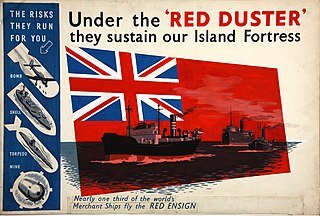
A merchant navy or merchant marine is the fleet of merchant vessels that are registered in a specific country. On merchant vessels, seafarers of various ranks and sometimes members of maritime trade unions are required by the International Convention on Standards of Training, Certification and Watchkeeping for Seafarers (STCW) to carry Merchant Mariner's Documents.
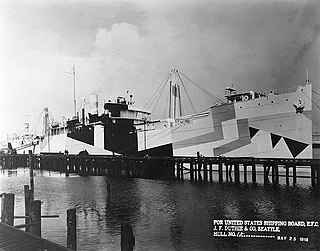
USS West Bridge (ID-2888) was a Design 1013 cargo ship in the United States Navy during World War I. She was begun as War Topaz for the British Government but was completed as West Bridge. After being decommissioned from the Navy, the ship returned to civilian service as West Bridge, but was renamed Barbara Cates, and Pan Gulf over the course of her commercial career under American registry.
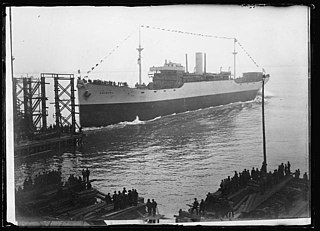
The Merchant Shipbuilding Corporation was an American corporation established in 1917 by railroad heir W. Averell Harriman to build merchant ships for the Allied war effort in World War I. The MSC operated two shipyards: the former shipyard of John Roach & Sons at Chester, Pennsylvania, and a second, newly established emergency yard at Bristol, Pennsylvania, operated by the MSC on behalf of the U.S. Shipping Board's Emergency Fleet Corporation (EFC).

USS West Haven (ID-2159) was a steel–hulled freighter that saw service with the U.S. Navy during World War I, and which later saw convoy service during the Battle of the Atlantic in World War II.

The Design 1013 ship, also known as the Robert Dollar type, was a steel-hulled cargo ship design approved for mass production by the United States Shipping Board's Emergency Fleet Corporation (EFT) in World War I. Like many of the early designs approved by the EFT, the Design 1013 did not originate with the EFT itself but was based on an existing cargo ship design, in this case one developed by the Skinner & Eddy Corporation of Seattle, Washington.

SS Logan Victory was a cargo Victory ship built for World War II under the Emergency Shipbuilding program. The Logan Victory was launched January 16, 1945, by Permanente Metals Corporation, Richmond, California and completed on February 6, 1945. She was operated by the American-Hawaiian Steamship Company under the United States Maritime Commission.

SS Hobbs Victory was a cargo Victory ship built for World War II under the Emergency Shipbuilding program. Hobbs Victory, was launched on January 9, 1945 by Permanente Metals Corporation, Richmond, California and completed on January 9, 1945. She was built in just 87 days. She was operated by the Sudden & Christenson for the United States Maritime Commission.

SS New Bern Victory was a cargo Victory ship built during World War II under the Emergency Shipbuilding program. The New Bern Victory (MCV-639) was a type VC2-S-AP2 Victory ship built by Bethlehem-Fairfield Shipyards. The Maritime Administration cargo ship was the 639 ship built. Her keel was laid on January 15, 1945. She was launched on March 8, 1945 and completed on March 31, 1945. The 10,600-ton ship was constructed for the Maritime Commission. The American Export Line and later the Isthmian Steamship Company operated her under the United States Merchant Marine act for the War Shipping Administration. Named for the city of New Bern, North Carolina.

The SS Bucknell Victory was a Victory-class cargo ship built during World War II. The Bucknell Victory was a type VC2-S-AP2 victory ship built by Permanente Metals Corporation, Yard 2, of Richmond, California. The Maritime Administration cargo ship was the 728th ship built. Her keel was laid on December 27, 1944. SS Bucknell Victory was an armed cargo ship, named for Bucknell University in Pennsylvania, one of 150 educational institutions that had Victory ships named after them. She was built in just 70 days, under the Emergency Shipbuilding program for World War II. The 10,600-ton ship was constructed for the Maritime Commission.

SS Attleboro Victory was a Victory ship built for the War Shipping Administration late in World War II under the Emergency Shipbuilding program. It saw service in the European Theater of Operations in the Atlantic Ocean during 1945, and in the immediate post-war period. Attleboro Victory was part of the series of Victory ships named after famous cities. This particular ship was named after the city of Attleboro, Massachusetts. It was a type VC2-S-AP2/WSAT cargo ship with the United States Maritime Commission (MCV) -"Victory"; hull number 642, shipyard number 1597 and built by Bethlehem Shipbuilding Corporation in Baltimore, Maryland. Phyllis O'Neil of Attleboro, Massachusetts christened Attleboro Victory with a champagne bottle.